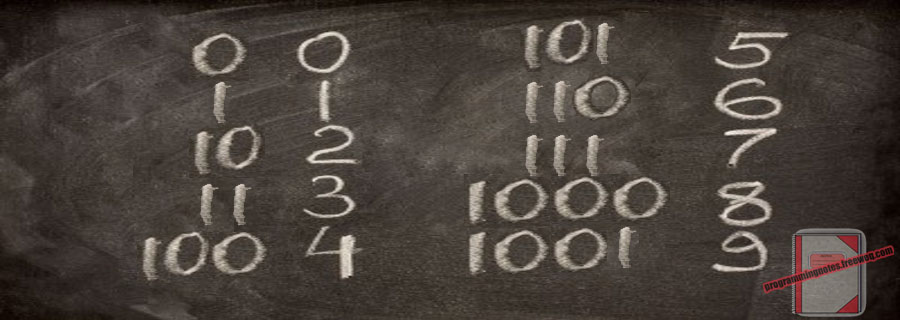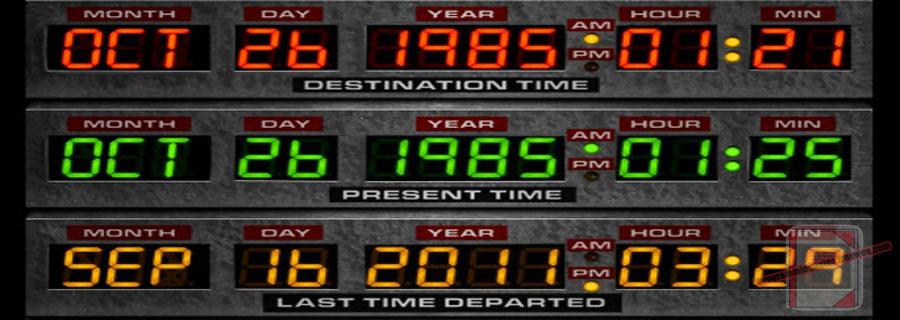Tag Archives: modulus
C++ || Snippet – How To Convert A Decimal Number Into Binary

This page will demonstrate how to convert a decimal number (i.e a whole number) into its binary equivalent. So for example, if the decimal number of 26 was entered into the program, it would display the converted binary value of 11010.
REQUIRED KNOWLEDGE FOR THIS SNIPPET
How To Count In Binary
The "Long" Datatype - What Is It?
While Loops
Online Binary to Decimal Converter - Verify For Correct Results
How To Reverse A String
If you are looking for sample code which converts binary to decimal, check back here soon!
|
1 2 3 4 5 6 7 8 9 10 11 12 13 14 15 16 17 18 19 20 21 22 23 24 25 26 27 28 29 30 31 32 33 34 35 36 37 38 39 40 41 42 43 44 45 46 47 48 49 50 51 52 53 |
#include <iostream> #include <string> #include <algorithm> using namespace std; // function prototype string DecToBin(long long decNum); int main() { // declare variables long long decNum = 0; string binaryNum=""; // use a string instead of an int to avoid // overflow, because binary numbers can grow large quick cout<<"Please enter an integer value: "; cin >> decNum; if(decNum < 0) { binaryNum = "-"; } // call function to convert decimal to binary binaryNum += DecToBin(decNum); // display data to user cout<<"nThe integer value of "<<decNum<<" = "<<binaryNum<<" in binary"<<endl; return 0; } string DecToBin(long long decNum) { string binary = ""; // use this string to save the binary number if(decNum < 0) // if input is a neg number, make it positive { decNum *= -1; } // converts decimal to binary using division and modulus while(decNum > 0) { binary += (decNum % 2)+'0'; // convert int to char decNum /= 2; } // reverse the string reverse(binary.begin(), binary.end()); return binary; }// http://programmingnotes.org/ |
The highlighted lines are sections of interest to look out for.
The code is heavily commented, so no further insight is necessary. If you have any questions, feel free to leave a comment below.
Once compiled, you should get this as your output
Note: The code was compiled 3 separate times to display different output
====== RUN 1 ======Please enter an integer value: 1987
The integer value of 1987 = 11111000011 in binary
====== RUN 2 ======
Please enter an integer value: -26
The integer value of -26 = -11010 in binary
====== RUN 3 ======
Please enter an integer value: 12345678910
The integer value of 12345678910 = 1011011111110111000001110000111110 in binary
Java || Modulus – Celsius To Fahrenheit Conversion Displaying Degrees Divisible By 10 Using Modulus

This page will consist of two simple programs which demonstrate the use of the modulus operator (%).
REQUIRED KNOWLEDGE FOR THIS PROGRAM
Modulus
Do/While Loop
Methods (A.K.A "Functions") - What Are They?
Simple Math - Divisibility
Celsius to Fahrenheit Conversion
===== FINDING THE DIVISIBILITY OF A NUMBER =====
Take a simple arithmetic problem: what’s left over when you divide an odd number by an even number? The answer may not be easy to compute, but we know that it will most likely result in an answer which has a decimal remainder. How would we determine the divisibility of a number in a programming language like Java? That’s where the modulus operator comes in handy.
To have divisibility means that when you divide the first number by another number, the quotient (answer) is a whole number (i.e – no decimal values). Unlike the division operator, the modulus operator (‘%’), has the ability to give us the remainder of a given mathematical operation that results from performing integer division.
To illustrate this, here is a simple program which prompts the user to enter a number. Once the user enters a number, they are asked to enter in a divisor for the previous number. Using modulus, the program will determine if the second number is divisible by the first number. If the modulus result returns 0, the two numbers are divisible. If the modulus result does not return 0, the two numbers are not divisible. The program will keep re-prompting the user to enter in a correct choice until a correct result is obtained.
|
1 2 3 4 5 6 7 8 9 10 11 12 13 14 15 16 17 18 19 20 21 22 23 24 25 26 27 28 29 30 31 32 33 34 35 36 37 38 39 40 41 42 43 44 45 46 47 48 49 50 51 52 |
import java.util.Scanner; public class Modulus { // global variable declaration static Scanner cin = new Scanner(System.in); public static void main(String[] args) { // declare & initialize variables int numerator = 0; int denominator = 0; double multiple = 0; System.out.println("Welcome to My Programming Notes' Java Program.n"); // get first number System.out.print("Please enter a value: "); numerator = cin.nextInt(); // get second number System.out.print("nPlease enter a factor of "+numerator+": "); do{ // loop will keep going until the user enters a correct answer denominator = cin.nextInt(); // this is the modulus declaration, which will find the // remainder between the 2 numbers multiple = numerator % denominator; // if the modulus result returns 0, the 2 numbers // are divisible if(multiple == 0) { System.out.println("nCorrect! "+numerator+" is divisible by " +denominator); System.out.println("n("+numerator+"/"+denominator+") = " + ""+(numerator/denominator)); } // if the user entered an incorrect choice, promt an error message else { System.out.print("nIncorrect, "+numerator+" is not divisible by " +denominator); System.out.print(".nnPlease enter a new multiple integer for " +numerator+": "); } }while(multiple != 0); // ^ loop stops once user enters correct choice }// end of main }// http://programmingnotes.org/ |
The above program determines if number ‘A’ is divisible be number ‘B’ via modulus. Unlike the division operator, which does not return the remainder of a number, the modulus operator does, thus we are able to find divisibility between two numbers.
To demonstrate the above code, here is a sample run:
Welcome to My Programming Notes' Java Program.Please enter a value: 21
Please enter a factor of 21: 5Incorrect, 21 is not divisible by 5.
Please enter a new multiple integer for 21: 7
Correct! 21 is divisible by 7(21/7) = 3
===== CELSIUS TO FAHRENHEIT CONVERSION DISPLAYING DEGREES DIVISIBLE BY 10 =====
Now that we understand how modulus works, the second program shouldn’t be too difficult. This function first prompts the user to enter in an initial (low) value. After the program obtains the low value from the user, the program will ask for another (high) value. After it obtains the needed information, it displays all the degrees, from the range of the low number to the high number, which are divisible by 10. So if the user enters a low value of 3 and a high value of 303, the program will display all of the Celsius to Fahrenheit degrees within that range which are divisible by 10.
|
1 2 3 4 5 6 7 8 9 10 11 12 13 14 15 16 17 18 19 20 21 22 23 24 25 26 27 28 29 30 31 32 33 34 35 36 37 38 39 40 41 42 43 44 45 46 47 48 49 50 51 52 53 54 55 56 57 58 59 60 |
import java.util.Scanner; public class Temperature { // global variable declaration static Scanner cin = new Scanner(System.in); public static void main(String[] args) { // declare & initialize variables int low = 0; int high = 0; double degreeFahrenhiet = 0; double multiple = 0; System.out.println("Welcome to My Programming Notes' Java Program.n"); // get data from user System.out.print("Enter a low number: "); low = cin.nextInt(); System.out.print("nEnter a high number: "); high = cin.nextInt(); // displays data back to user in table form System.out.print("nCelsius Fahrenheit:n"); // display the initial 'low' converted degrees to the user System.out.println(low+"t"+ConvertCelsiusToFahrenheit(low)); // this loop displays all the degrees that are divisible by 10 do{ // this increments the current degree number by 1 ++low; // this converts the current number from celsius to fahrenhiet degreeFahrenhiet = ConvertCelsiusToFahrenheit(low); // this is the modulus operation which finds the // numbers which are divisible by 10 multiple = low % 10; // the program will only display the degrees to the user via // cout which are divisible by 10 if(multiple == 0) { System.out.println(low+"t"+degreeFahrenhiet); } }while(low < high); // ^ loop stops once the 'low' variable reaches the 'high' variable // displays the 'high' converted degrees to the user System.out.println(high+"t"+ConvertCelsiusToFahrenheit(high)); }// end of main static double ConvertCelsiusToFahrenheit(int degree) { return ((1.8 * degree) + 32.0); }// end of ConvertCelsiusToFahrenheit }// http://programmingnotes.org/ |
QUICK NOTES:
The highlighted lines are sections of interest to look out for.
The code is heavily commented, so no further insight is necessary. If you have any questions, feel free to leave a comment below.
Once compiled, you should get this as your output
Welcome to My Programming Notes' Java Program.Enter a low number: 3
Enter a high number: 303Celsius Fahrenheit:
3..........37.4
10.........50
20.........68
30.........86
40........104
50........122
60........140
70........158
80........176
90........194
100.......212
110.......230
120.......248
130.......266
140.......284
150.......302
160.......320
170.......338
180.......356
190.......374
200.......392
210.......410
220.......428
230.......446
240.......464
250.......482
260.......500
270.......518
280.......536
290.......554
300.......572
303.......577.4
Java || Snippet – How To Convert A Decimal Number Into Binary

This page will demonstrate how to convert a decimal number (i.e a whole number) into its binary equivalent. So for example, if the decimal number of 25 was entered into the program, it would display the converted binary value of 11001.
REQUIRED KNOWLEDGE FOR THIS SNIPPET
How To Count In Binary
The "Long" Datatype - What Is It?
Methods (A.K.A "Functions") - What Are They?
While Loops
Online Binary to Decimal Converter - Verify For Correct Results
If you are looking for sample code which converts binary to decimal, check back here soon!
|
1 2 3 4 5 6 7 8 9 10 11 12 13 14 15 16 17 18 19 20 21 22 23 24 25 26 27 28 29 30 31 32 33 34 35 36 37 38 39 40 41 42 43 44 45 46 47 48 49 50 51 52 53 54 55 |
import java.util.Scanner; public class DecimalToBinary { // global variable declaration static Scanner cin = new Scanner(System.in); public static void main(String[] args) { // declare variables long decNum = 0; String binaryNum = ""; // use a string instead of an int to avoid // overflow, because binary numbers can grow large quick // display message to screen System.out.println("Welcome to My Programming Notes' Java Program.n"); // get decimal number from user System.out.print("Please enter an integer value: "); decNum = cin.nextLong(); if(decNum < 0) // if user inputs a neg number, make the binary num neg too { binaryNum = "-"; } // method call to convert decimal to binary binaryNum += DecToBin(decNum); // display data to user System.out.println("nThe integer value of "+ decNum + " = " + binaryNum + " in binary"); }// end of main public static String DecToBin(long decNum) { // use this string to save the binary number String binary = ""; if(decNum < 0) // if input is a neg number, make it positive { decNum *= -1; } // converts decimal to binary using division and modulus while(decNum > 0) { binary += (decNum % 2); decNum /= 2; } // return the reversed string to main return new StringBuffer(binary).reverse().toString(); } }// http://programmingnotes.org/ |
QUICK NOTES:
The highlighted lines are sections of interest to look out for.
The code is heavily commented, so no further insight is necessary. If you have any questions, feel free to leave a comment below.
Once compiled, you should get this as your output
Note: The code was compiled 3 separate times to display different output
====== RUN 1 ======Welcome to My Programming Notes' Java Program.
Please enter an integer value: 5
The integer value of 5 = 101 in binary
====== RUN 2 ======
Welcome to My Programming Notes' Java Program.
Please enter an integer value: -25
The integer value of -25 = -11001 in binary
====== RUN 3 ======
Welcome to My Programming Notes' Java Program.
Please enter an integer value: 12345678910
The integer value of 12345678910 = 1011011111110111000001110000111110 in binary
C++ || Convert Time From Seconds Into Hours, Min, Sec Format

Here is another simple programming assignment. This page will demonstrate how to convert time from -seconds- into HH::MM::SS (hours, minutes seconds) format. So for example, if you had an input time of 9630 seconds, the program would display the converted time of 2 hours, 40 minutes, and 30 seconds.
Using simple math, this program utilizes the modulus operator, and the division operator during the conversion process.
REQUIRED KNOWLEDGE FOR THIS PROGRAM
Modulus - What is it?
How Many Seconds Are In One Hour?
How Many Seconds Are In One Minute?
|
1 2 3 4 5 6 7 8 9 10 11 12 13 14 15 16 17 18 19 20 21 22 23 24 25 26 27 28 29 30 31 32 33 34 35 36 37 38 |
// ============================================================================ // Author: Kenneth Perkins // Date: May 30, 2012 // Taken From: http://programmingnotes.org/ // File: Convert-Time.cpp // Description: Demonstrates how to convert time from -seconds- into // HH::MM::SS (hours, minutes, seconds) format // ============================================================================ #include <iostream> using namespace std; int main() { // declare variables int time = 0; int hour = 0; int min = 0; int sec = 0; // obtain data from user cout << "Enter a time in seconds: "; cin >> time; // using the time from ^ above, convert // secs to HH:MM:SS format using division // and modulus hour = time/3600; time = time%3600; min = time/60; time = time%60; sec = time; // display data to user cout<<"\nThe time in HH:MM:SS format is: "<<hour<<" hours, " <<min<<" minutes, and "<<sec<<" seconds!\n"; return 0; }// http://programmingnotes.org/ |
QUICK NOTES:
The highlighted lines are sections of interest to look out for.
The code is heavily commented, so no further insight is necessary. If you have any questions, feel free to leave a comment below.
Once compiled, you should get this as your output
(Note: the code was compiled five separate times to display different output)
====== RUN 1 ======Enter a time in seconds: 9630
The time in HH:MM:SS format is: 2 hours, 40 minutes, and 30 seconds!
====== RUN 2 ======
Enter a time in seconds: 7200
The time in HH:MM:SS format is: 2 hours, 0 minutes, and 0 seconds!
====== RUN 3 ======
Enter a time in seconds: 45
The time in HH:MM:SS format is: 0 hours, 0 minutes, and 45 seconds!
====== RUN 4 ======
Enter a time in seconds: 134
The time in HH:MM:SS format is: 0 hours, 2 minutes, and 14 seconds!
====== RUN 5 ======
Enter a time in seconds: 31536000
The time in HH:MM:SS format is: 8760 hours, 0 minutes, and 0 seconds!
C++ || Snippet – Round A Number To The Nearest Whole Number

This page will display a simple implementation of a function which rounds a floating point number to the nearest whole number. So for example, if the number 12.34542 was sent to the function, it would return the rounded value of 12.
REQUIRED KNOWLEDGE FOR THIS SNIPPET
|
1 2 3 4 5 6 7 8 9 10 11 12 13 14 15 16 17 18 19 20 21 22 23 24 25 26 27 28 29 30 31 32 33 34 35 36 37 |
#include <iostream> #include <cmath> using namespace std; // function prototype double RoundNumber(double floatNumber); int main() { // declare variables double floatNumber = 0; cout<<"Enter in a floating point number to round: "; cin >> floatNumber; cout<<endl<<floatNumber<<" rounded to the nearest " "whole number is: "<< RoundNumber(floatNumber)<<endl; return 0; } double RoundNumber(double floatNumber) { // declare variables double intNumber = 0; // perform modulus (floatNumber % intNumber) // to render the decimal portion of the floatNumber double fraction = modf(floatNumber,&intNumber); // we round up if fraction >=.50 if(fraction >=.50) { ++intNumber; } return intNumber; }// http://programmingnotes.org/ |
QUICK NOTES:
The highlighted lines are sections of interest to look out for.
The code is heavily commented, so no further insight is necessary. If you have any questions, feel free to leave a comment below.
Once compiled, you should get this as your output
(Note: the code was compile three separate times to display different output)
====== RUN 1 ======Enter in a floating point number to round: 1.3333
1.3333 rounded to the nearest whole number is: 1
====== RUN 2 ======
Enter in a floating point number to round: 35.56
35.56 rounded to the nearest whole number is: 36
====== RUN 3 ======
Enter in a floating point number to round: 19.8728
19.8728 rounded to the nearest whole number is: 20
C++ || Snippet – How To Reverse An Integer Using Modulus & While Loop

This page will consist of a simple program which demonstrates how to reverse an integer (not an int array) using modulus and a while loop.
REQUIRED KNOWLEDGE FOR THIS SNIPPET
|
1 2 3 4 5 6 7 8 9 10 11 12 13 14 15 16 17 18 19 20 21 22 23 24 25 26 27 28 29 30 31 32 33 34 35 36 37 38 |
#include <iostream> using namespace std; // function prototype int ReverseNumber(int number); int main() { // declare variables int number = 0; int numReversed = 0; // get data from user cout << "Enter a number: "; cin >> number; // function call which will return the reversed number numReversed = ReverseNumber(number); // display new data to user cout <<endl<< number << " reversed is: "<< numReversed <<endl; return 0; }// end of main int ReverseNumber(int number) { // declare function variable int rev=0; while(number > 0) { rev = rev * 10 + (number % 10); number = number/10; } return rev; }// http://programmingnotes.org/ |
QUICK NOTES:
The highlighted lines are sections of interest to look out for.
The code is heavily commented, so no further insight is necessary. If you have any questions, feel free to leave a comment below.
Once compiled, you should get this as your output
(Note: the code was compiled three separate times to display different output)
==== RUN #1 ====Enter a number: 2012
2012 reversed is: 2102==== RUN #2 ====
Enter a number: 1987
1987 reversed is: 7891==== RUN #3 ====
Enter a number: 241
241 reversed is: 142
C++ || Cash Register Simulation – Display The Total Sales Amount In Dollars & Cents Using Modulus

The following is a simple program which demonstrates more use of the modulus (%) function to manipulate integer data.
REQUIRED KNOWLEDGE FOR THIS PROGRAM
This program first prompts the user to enter in a monetary amount into the system. This number can be a decimal number, or a whole number. Once the user enters in an amount, the program will use the modulus operator to determine exactly how many 1 dollar bills, quarters, dimes, nickles, and pennies consisted of the amount that the user entered into the program. So for example, if the user entered the value of 2.34, the program would display the result of 2 dollars, 1 quarters, 0 dimes, 1 nickels, and 4 pennies.
|
1 2 3 4 5 6 7 8 9 10 11 12 13 14 15 16 17 18 19 20 21 22 23 24 25 26 27 28 29 30 31 32 33 34 35 36 37 38 39 40 41 42 43 44 45 46 47 48 49 50 51 52 53 54 55 56 57 58 |
// ============================================================================ // Author: Kenneth Perkins // Date: Feb 28, 2012 // Taken From: http://programmingnotes.org/ // File: MakeChange.cpp // Description: The following is a simple program which demonstrates // how to make change. // ============================================================================ #include<iostream> using namespace std; int main() { // declare variables double initialAmount = 0; int remainingAmount = 0; int numberOfOneDollars = 0; int numberOfQuarters = 0; int numberOfDimes = 0; int numberOfNickels = 0; int numberOfPennies = 0; // Receive the amount cout << "Enter the total sales amount in dollars & cents (for example 19.87): "; cin >> initialAmount; // convert a 'double' to 'int' value remainingAmount = static_cast<int>(initialAmount * 100); // Find the number of one dollars numberOfOneDollars = remainingAmount / 100; remainingAmount = remainingAmount % 100; // Find the number of quarters in the remaining amount numberOfQuarters = remainingAmount / 25; remainingAmount = remainingAmount % 25; // Find the number of dimes in the remaining amount numberOfDimes = remainingAmount / 10; remainingAmount = remainingAmount % 10; // Find the number of nickels in the remaining amount numberOfNickels = remainingAmount / 5; remainingAmount = remainingAmount % 5; // Find the number of pennies in the remaining amount numberOfPennies = remainingAmount; // Display the results cout << "\nThe amount of $" << initialAmount << " consists of: \n" << "\t" << numberOfOneDollars << " dollar(s)\n" << "\t" << numberOfQuarters << " quarter(s)\n" << "\t" << numberOfDimes << " dime(s)\n" << "\t" << numberOfNickels << " nickel(s)\n" << "\t" << numberOfPennies << " pennie(s)\n"; return 0; }// http://programmingnotes.org/ |
QUICK NOTES:
The highlighted lines are sections of interest to look out for.
The code is heavily commented, so no further insight is necessary. If you have any questions, feel free to leave a comment below.
Once compiled, you should get this as your output
(Note: the code was compile three separate times to display different output)
====== RUN 1 ======Enter the total sales amount in dollars & cents (for example 19.87): 19.87
The amount of $19.87 consists of:
19 dollar(s)
3 quarter(s)
1 dime(s)
0 nickel(s)
2 pennie(s)====== RUN 2 ======
Enter the total sales amount in dollars & cents (for example 19.87): 11.93
The amount of $11.93 consists of:
11 dollar(s)
3 quarter(s)
1 dime(s)
1 nickel(s)
3 pennie(s)====== RUN 3 ======
Enter the total sales amount in dollars & cents (for example 19.87): 3.00
The amount of $3 consists of:
3 dollar(s)
0 quarter(s)
0 dime(s)
0 nickel(s)
0 pennie(s)
C++ || Modulus – Celsius To Fahrenheit Conversion Displaying Degrees Divisible By 10 Using Modulus

This page will consist of two simple programs which demonstrate the use of the modulus operator (%).
REQUIRED KNOWLEDGE FOR THIS PROGRAM
Modulus
Do/While Loop
Functions
Simple Math - Divisibility
Celsius to Fahrenheit Conversion
===== FINDING THE DIVISIBILITY OF A NUMBER =====
Take a simple arithmetic problem: what’s left over when you divide an odd number by an even number? The answer may not be easy to compute, but we know that it will most likely result in an answer which has a decimal remainder. How would we determine the divisibility of a number in a programming language like C++? That’s where the modulus operator comes in handy.
To have divisibility means that when you divide the first number by another number, the quotient (answer) is a whole number (i.e – no decimal values). Unlike the division operator, the modulus operator (‘%’), has the ability to give us the remainder of a given mathematical operation that results from performing integer division.
To illustrate this, here is a simple program which prompts the user to enter a number. Once the user enters a number, they are asked to enter in a divisor for the previous number. Using modulus, the program will determine if the second number is divisible by the first number. If the modulus result returns 0, the two numbers are divisible. If the modulus result does not return 0, the two numbers are not divisible. The program will keep re-prompting the user to enter in a correct choice until a correct result is obtained.
|
1 2 3 4 5 6 7 8 9 10 11 12 13 14 15 16 17 18 19 20 21 22 23 24 25 26 27 28 29 30 31 32 33 34 35 36 37 38 39 40 41 42 43 44 45 |
#include <iostream> using namespace std; int main() { // declare variables int base=0; int userInput=0; double multiple =0; // get first number cout <<"Please enter a value: "; cin >> base; // get second number cout << "nPlease enter a factor of "<<base<<": "; cin >> userInput; do{ // loop will keep going until the user enters a correct answer // this is the modulus declaration, which will find the // remainder between the 2 numbers multiple = base % userInput; // if the modulus result returns 0, the 2 numbers // are divisible if (multiple == 0) { cout <<"nCorrect! " << base << " is divisible by " << userInput <<endl; cout <<"n("<< base << "/" << userInput <<") = "<<(base/userInput)<<endl; } // if the user entered an incorrect choice, promt an error message else { cout << "nIncorrect, " << base <<" is not divisible by " << userInput <<".nPlease enter a new multiple integer for that value: "; cin >> userInput; } }while(multiple != 0); // ^ loop stops once user enters correct choice return 0; }// http://programmingnotes.org/ |
The above program determines if number ‘A’ is divisible be number ‘B’ via modulus. Unlike the division operator, which does not return the remainder of a number, the modulus operator does, thus we are able to find divisibility between two numbers.
To demonstrate the above code, here is a sample run:
Please enter a value: 21
Please enter a factor of 21: 5Incorrect, 21 is not divisible by 5.
Please enter a new multiple integer for that value: 7Correct! 21 is divisible by 7
(21/7) = 3
===== CELSIUS TO FAHRENHEIT CONVERSION =====
Now that we understand how modulus works, the second program shouldn’t be too difficult. This function first prompts the user to enter in an initial (low) value. After the program obtains the low value from the user, the program will ask for another (high) value. After it obtains the needed information, it displays all the degrees, from the range of the low number to the high number, which are divisible by 10. So if the user enters a low value of 3 and a high value of 303, the program will display all of the Celsius to Fahrenheit degrees within that range which are divisible by 10.
|
1 2 3 4 5 6 7 8 9 10 11 12 13 14 15 16 17 18 19 20 21 22 23 24 25 26 27 28 29 30 31 32 33 34 35 36 37 38 39 40 41 42 43 44 45 46 47 48 49 50 51 52 53 54 55 56 57 58 |
#include <iostream> using namespace std; // function prototype double ConvertCelsiusToFahrenheit(int degree); int main() { // declare variables int low=0; int high=0; double degreeFahrenhiet =0; double multiple =0; // get data from user cout << "Enter a low number: "; cin >> low; cout << "nEnter a high number: "; cin >> high; // displays data back to user in table form cout <<"nCelsius Fahrenheit:n"; cout << low << "t" << ConvertCelsiusToFahrenheit(low)<<endl; ++low; // this loop displays all the degrees that are divisible by 10 do{ // this converts the current number from celsius to fahrenhiet degreeFahrenhiet = ConvertCelsiusToFahrenheit(low); // this is the modulus operation which finds the // numbers which are divisible by 10 multiple = low % 10; // the program will only display the degrees to the user via // cout which are divisible by 10 if(multiple ==0) { cout << low << "t" << degreeFahrenhiet<<endl; } // this increments the current degree number by 1 ++low; }while(low < high); // ^ loop stops once the 'low' variable reaches the 'high' variable // displays the 'high' converted degrees to the user cout << high << "t" << ConvertCelsiusToFahrenheit(high)<<endl; return 0; }// end of main // function declaration which returns the converted celsius to fahrenhiet value double ConvertCelsiusToFahrenheit(int degree) { return ((1.8 * degree) + 32.0); }// http://programmingnotes.org/ |
QUICK NOTES:
The highlighted lines are sections of interest to look out for.
The code is heavily commented, so no further insight is necessary. If you have any questions, feel free to leave a comment below.
Once compiled, you should get this as your output
Enter a low number: 3
Enter a high number: 303Celsius Fahrenheit:
3..........37.4
10.........50
20.........68
30.........86
40........104
50........122
60........140
70........158
80........176
90........194
100.......212
110.......230
120.......248
130.......266
140.......284
150.......302
160.......320
170.......338
180.......356
190.......374
200.......392
210.......410
220.......428
230.......446
240.......464
250.......482
260.......500
270.......518
280.......536
290.......554
300.......572
303.......577.4












